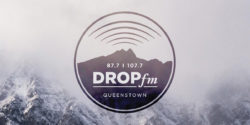Catching a low-power FM radio station in the wild in New Zealand requires a bit of luck. Permitted to broadcast with up to one watt of power without a license, these stations have a bit more range – generally up to one kilometer radius (.6 miles) – than a legal unlicensed Part 15 station in the US, which might be heard up to a quarter-mile away. However, that’s still not a big footprint, even when compared to licensed LPFMs stateside, which may broadcast with as much as 100x as the NZ stations.
One factor working in the listener’s favor is that the country’s LPFMs are consigned to a set of frequencies bookending the FM dial: 86.7 to 88.3 mHz on the left end and 106.7 to 107.7 MHz on the right end. When I talked with Kristen Paterson, station manager of Wellington Access Radio and a co-founder of a university LPFM, she conjectured that the top end LPFM band was set aside as a kind of buffer between full-power broadcasts and the air traffic band situated just north of FM.
Regardless of the reason why they’re relegated to the far-left and far-right ends of the FM dial, knowing this makes it a little easier to hunt for them. That said, during my time in the country in late January and early February, I could confirm reception of only two.
The first catch was in Browns Bay, in the East Coast Bays area of Auckland, the country’s largest city. I tuned in what I believe to be Great Tech Radio at 107.7 FM. I say “believe to be” because over the course of an hour or so I never heard a legal ID. I did hear an assortment of oldies, from Diana Ross and the Supremes to the Bee Gees, along with a 60s comedy record, accompanied by back announcing and weather forecasts. Those forecasts included days prior and after my listening time, leading me to believe the station was automated and the forecasts weren’t the freshest.
I identified Great Tech based upon several online LPFM directories, though I won’t hold to that ID if challenged. Given that they’re unlicensed and don’t require much investment to put on the air, New Zealand’s LPFMs are quite transitory, and I found rather few that maintain a regular web presence.
My second catch was in the resort city of Queenstown, located in the southwest part of the South Island. It’s a beautiful setting along the shore of Lake Wakatipu, surrounded by mountains.
Drop FM came in loud and clear for me on 87.7 FM. I first heard 90s vintage drum ’n bass music, which I learned is a staple for the station when I googled it. The station stands out from other New Zealand LPFMs by having a very consistent web presence, along with an internet stream. In fact it has two other frequencies in Wanaka, north of Queenstown, and the suburb of Frankton.
Drop FM broadcasts live from dance clubs in Queenstown on a regular basis – though, understandably, corona virus seems to have put those events on hold. While drum n’ bass and related electronic genres seem to be the station’s bedrock, I also enjoyed a long set of eclectic R&B one evening as I was packing up to leave for my next stop.
I last stayed in Wellington, the country’s capital. I’m sad to report I was unable to confirm reception of any LPFMs over the course of several evenings. Perhaps the city’s hilly geography – it resembles San Francisco in that way – worked against me. Or maybe there just weren’t any active stations in a one kilometer radius from my Air BnB.
I remain fascinated by this broadcast service, since, to the best of my knowledge, New Zealand has the highest power allowed for legal unlicensed broadcasting anywhere in the world. Setting aside a set number of frequencies seems to be an effective way of allowing more voices on the air at a very low cost, while also giving an outlet to broadcasters who might otherwise go “pirate.” This was my second visit to New Zealand, and I do intend to visit again. When I do, I’m tempted to bring a small transmitter to set up my own temporary LPFM.
I still can’t help but think that such a service in the US could help stem the tide of unlicensed broadcasters in the urban areas of Boston, New York, New Jersey and South Florida, while also providing an opportunity for communities and groups that weren’t able to get on the air during the last LPFM licensing window in 2013. Though the FM dial is pretty well full in most metropolitan areas, I suggest that the band could be extended a little to the left, to encompass frequencies mostly vacated by former analog channel 6 TV stations.
Of course, this proximity to the FM dial has long been exploited by the handful of analog low-power TV stations still broadcasting on channel 6, which by and large now primarily operate as radio stations at 87.7 FM rather than TV stations, often known as FrankenFMs. The FCC is currently deciding the fate of those stations, since all TV is really supposed to be digital, and their transition deadline has been pushed repeatedly over the last five years. I propose that if channel 6 low-power TV stations are allowed to stay analog, keeping their near-FM broadcast signal, then that extra little bit of dial space should be given over to unlicensed LPFM everywhere else, where there isn’t an existing channel 6. Keep the limit to 1 watt, and maybe let them have 87.9 FM, too. I can see little harm, and much benefit.
However, reality is that even that little bit of uncommercialized real estate is unlikely to be tolerated by the National Association of Broadcasters, nor National Public Radio, whom I expect would lobby heartily against such a radical notion.
Still, I can dream… until my next trip to New Zealand.



